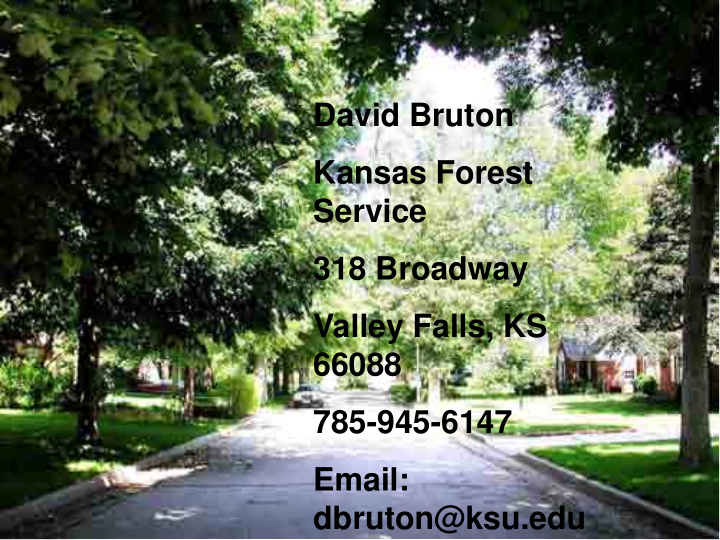



David Bruton • David Bruton Kansas Forest • Kansas Forest Service Service • 318 Broadway • Valley Falls, KS 66088 318 Broadway • 785-945-6147 • Email: dbruton@ksu.edu Valley Falls, KS 66088 785-945-6147 Email: dbruton@ksu.edu
Benefits of Trees • Provide cooling and heating benefits • Provide cleaner air • Reduce use/reliance on fossil fuels • Reduce storm water runoff and soil erosion • Improve water quality • Block and mask noise for increased privacy • Dramatically increase property values and sales • Provide recreational opportunities • Enhance wildlife habitat • Provide social and psychological benefits
Trusty Trees “The net cooling effect of a young, healthy tree is equivalent to ten room-size air conditioners operating 20 hours a day.” –U.S. Department of Agriculture “Trees properly placed around buildings can reduce air conditioning needs by 30 percent and can save 20 – 50 percent in energy used for heating.” –USDA Forest Service “Nationally, the 60 million street trees have an average value of $525 per tree.” -Management Information Services
During the summer, trees provide shade that helps reduce radiant energy stored and absorbed by buildings and other infrastructure. During the winter properly placed trees can provide reduced wind speeds that reduce heat loss.
Energy Conservation 3 Ways in which houses gain or lose heat 1. Air Infiltration: movement of outside air (hot or cold) into the home through cracks around doors, windows, porous materials, and other openings. The average home loses 20% – 33% of heat from air infiltration. 2. Heat Conduction: measure of the thermal conductivity of a given material. A way of comparing the rate at which heat can be transferred through materials. Heat conduction/transfer represents 33% - 50% of total heat exchange between a house and the surrounding environment. 3. Radiation transmission: amount of solar radiation transmitted through windows or other glazed surfaces.
Trees provide Energy Conservation through the management of: Wind (air infiltration) Sun (radiation heat and transmission)
Winter Conditions • Winter sun is lower in the sky but still a reliable source of solar heating. • Winter winds in Kansas are generally from north-west. Winds accelerate rate of air exchange between a house’s exterior and interior environments – increases heating energy demands. • Winter landscapes – should block winter winds and allow capture of sun’s rays.
Summer Conditions * Kansas summer winds typically come from the south. * Proper location of tree and shrub plantings can help channel summer winds which can aid in cooling.
Direct Cooling Trees provide cooling benefits: 1. By reflecting sunlight and providing shade, thus preventing sunlight from reaching hard surfaces (concrete, asphalt, brick) which converts solar radiation into heat. 2. By releasing water vapor through leaf surfaces, known as evapotranspiration, warm air is cooled naturally.
Five Principles • West is Best • Keep it Cool • Let the Sunshine In • Up and Over • The more the Merrier
West is Best • Proper location is the key – A properly placed tree can conserve up to 300 kilowatt hours/year. • West planting provide the shade benefit during the summer while allowing the south side to remain open for sunlight penetration during the winter • Shading roofs from western summer sun can reduce inside temperatures as much as 8 – 10 degrees. • Tree selection determined by height, form, density, and planting area.
Keep it Cool • Air conditioners operate more efficiently (up to 10% - 15%) when in a cooler, shaded environment, but care needs to be taken to maintain trees and other vegetation around units to provide adequate air circulation.
Let the Sunshine In • Winter time passive solar radiation can provide up to 20% of home’s heating for free. Mostly through south facing windows. • Limit tree planting, especially evergreens, on the south side of structures if taking advantage of solar radiation is primary objective.
Up and Over • Evergreen trees and shrubs planted on the north and west side of homes and other areas to be protected provide energy savings. • Established windbreaks that are 1 to 2 times the building height can reduce wind speeds by as much as 85%. Windbreaks provide good wind protection out 10 X Height. • Windbreaks consist of closely planted trees/shrubs…usually 10 – 12 ft. in- row spacing for evergreens and 4 – 6 ft. in-row for shrubs. Between row spacing varies depending on number of rows, and owner objectives.
The More the Merrier • Trees planted in groupings can benefit one another and sometimes provide maintenance advantages. • Group plantings can also help dissipate “Heat Islands” which resulting from structures, pavement, cars, etc. where temps. can be 5 – 10 degrees warmer than surrounding areas.
Sources of Information • National Arbor Day Foundation. Benefits of Trees. Found online at: http://www.arborday.org/trees/benefits.cfm • International Society of Arboriculture. Benefits of Trees. Found online at: http://www.treesaregood.com/treecare/tree_benefits.aspx • University of Washington. College of Forest Resources. Human Dimensions of Urban Forestry and Urban Greening. Found online at: http://www.cfr.washington.edu/research.envmind • Center for Urban Forest Research. PSW Research Station. Found online at: http://cufr.ucdavis.edu/default.asp • Windbreaks for Kansas. Found online at: http://www.ksre.ksu.edu/library/forst2/mf2120.pdf • Kansas Forest Service. http://www.kansasforests.org
In Summary • We can provide significant social, psychological, environmental, and energy conservation benefits with proper selection, placement and establishment of trees. • Trees are a valuable natural, renewable resource that provide more savings and benefits than their costs.
Recommend
More recommend